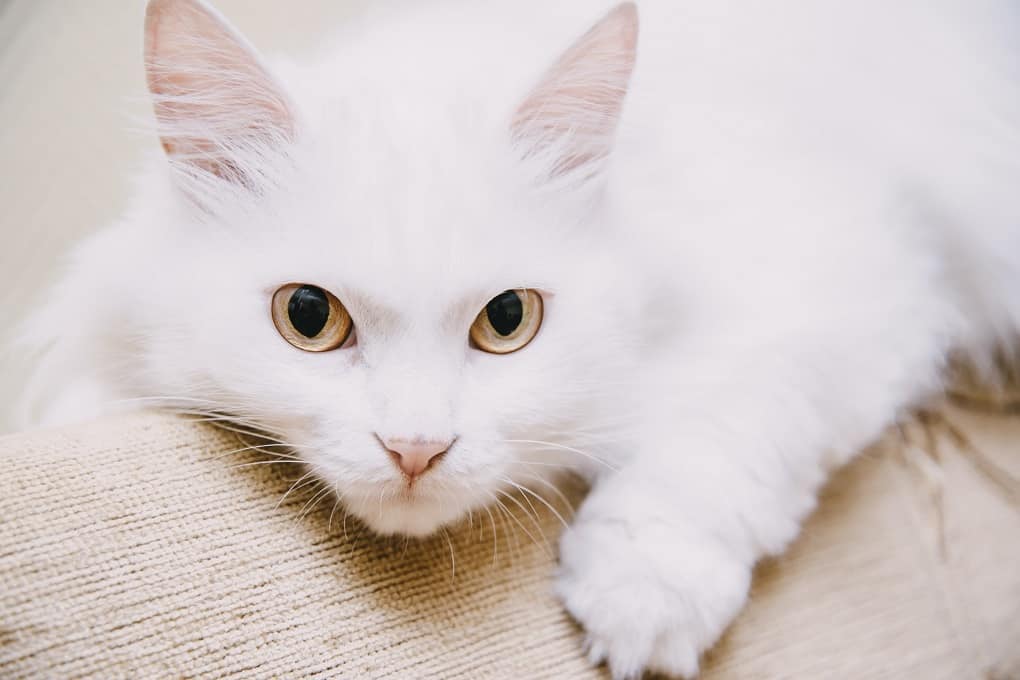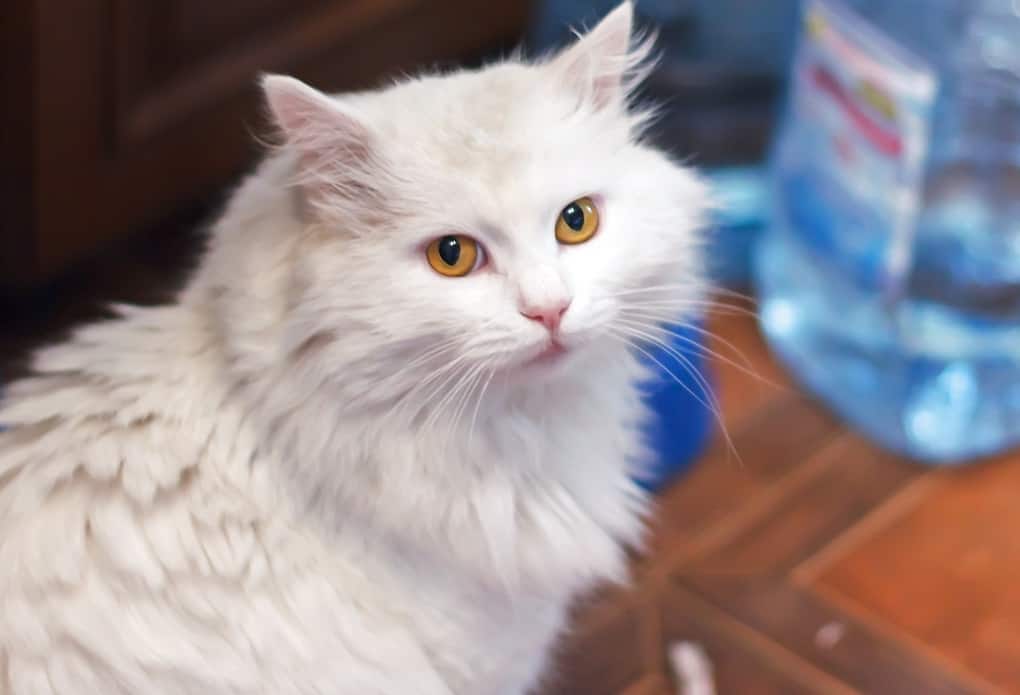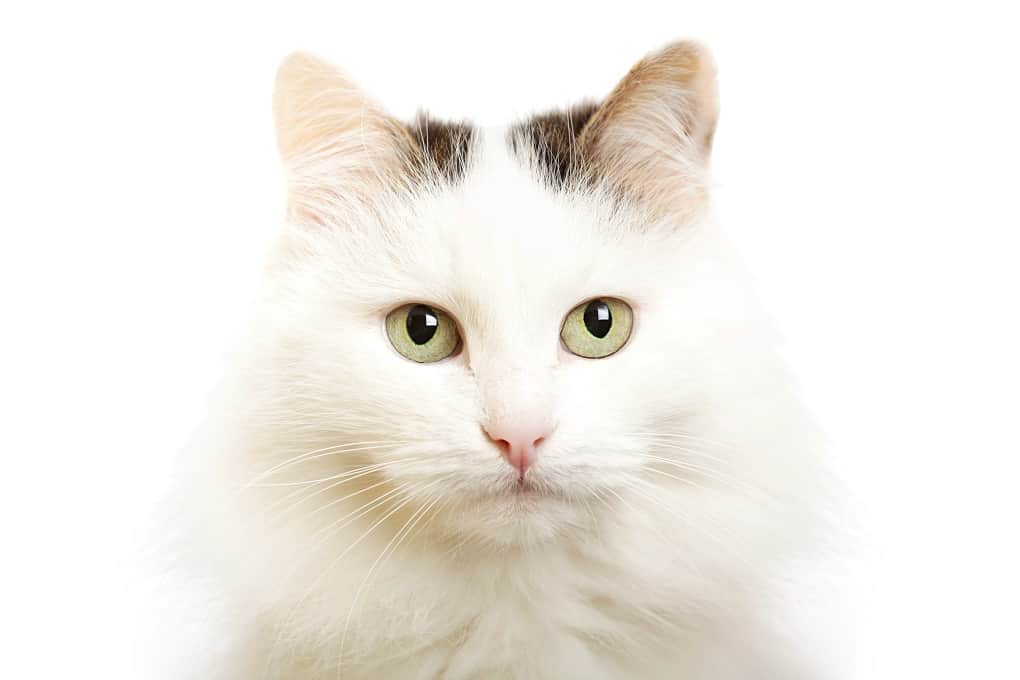Table of Contents

They say all cats are graceful, and that they always land on their feet. Well, that isn’t always the case. Take the Turkish Van for instance.
This lovable feline has a tendency to be a bit on the clumsy side, but it is loads of fun to have around. If you are looking for a cat that has a youthful personality and that loves its people, the Turkish Van is an excellent choice for you.
These cats are a bit on the large side, and many owners often say it’s like having a small dog around the house.
Origin and history of the breed
In Turkey, the Turkish Van is considered to be somewhat of a national treasure. This distinctive looking cat has the “van” coloration, white with a bit of color on the head and tail, with blue, gold, or odd colored eyes.
This cat was first discovered by two Westerners in the mid 50’s, photographers named Laura Lushington and Sonia Halliday. They were given a pair of these kittens while traveling to the area, and took them back to their home in England.
Below is a short video discussing some facts about Turkish Van:
While the Turkish Van is a relatively newer breed in the West, it is thought that this cat existed in Turkey’s Anatolian region for many centuries. This is a very rare cat, even in Turkey, where it is much-loved. Luckily, there are breeders who make it their life’s work to ensure that this breed is well-preserved.
Although the Turkish Van was recognized by The International Cat Association in 1979, it did not appear in the United States until 1982.
Physical standards of the breed

Now we are going to take a look at the physical standards of the Turkish Van, including any health issues, appearance, size, and more.
Health and possible diseases
When it comes to any purebred animal, there are likely to be some genetic health issues, and this is true of the Turkish Van. If you are talking to a breeder who tells you that these cats have no known health problems, move on to the next breeder, because this is someone who will say anything to sell one of their cats.
The Turkish Van isn’t prone to a lot of health problems, but they can tend to become obese if they aren’t fed a proper cat diet.
Grooming
Even though it looks like it would be a lot of work to groom a Turkish Van, it really isn’t much of an issue at all. All you have to do is comb its hair once or twice weekly, and keep its toenails trimmed, and that’s pretty much it.
These cats have a single, soft coat that is super-easy to care for. Turkish Vans love water, so you can bathe them, but this is not really necessary.
Finally, make sure that you brush your cat’s teeth once a week to prevent tooth decay and other oral health issues.
Height and size
The Turkish Van is one of the largest cats, and it is tall and muscular. It has a rather long body and tail, along with shoulders that are broad and strong.
The neck is short, giving this cat the appearance of a jock, which is fine since it is also quite energetic and athletic.
Weight
Depending on the sex, Turkish Vans can weigh anywhere from 12 to 18 pounds. The males tend to weigh a bit more than the females.
This is a cat that is prone to obesity, so it is important that you feed it a healthy, well-balanced diet to maintain a healthy weight.
Activeness
The Turkish Van is quite an energetic cat, and it can get itself into a lot of trouble. You will definitely need to kitty-proof your home before bringing one of these cats in.
It loves to run and jump, and even enjoys playing in the water. This is a cat that can play fetch, and it loves to attack its favorite cat toys and even wash them in the toilet or sink (they can become quite adept at turning on faucets).
When they are sitting still, this is a very loving and affectionate cat.
Hypoallergenic
If you are looking for a pet that is truly hypoallergenic, good luck in finding it. If it has fur, it is going to have allergens, period. But, this doesn’t mean that allergy sufferers can’t enjoy owning a cat.
You just need to make sure that it is properly cared for. For instance, a Turkish Van has a longer coat, so you will need to make sure that it is brushed regularly to get rid of dander and loose fur.
Vacuuming your home regularly will also help keep allergens at bay.
Lifespan
Like most cats, the Turkish Van has a normal life span of 10 to 15 years. Of course, it can live longer with the proper care, providing that it has no genetic health problems to begin with.
A healthy diet, regular vet visits, and keeping your cat indoors will help to extend its lifespan.
Caring Difficulty
There is a bit more work in caring for a long-haired cat as opposed to a short-haired cat, but it doesn’t have to be a chore. You should make sure that you are brushing your Turkish Van at least twice weekly, which will not only get rid of dead hair but also distribute skin oils.
Make sure that you trim its nails regularly, and keep your cat’s ears clean with a soft, damp cloth.
Where to get a Turkish Van
When it comes to getting a purebred cat, including a Turkish Van, the best option is to seek out a reputable breeder. Start by searching for breeders in your area.
You may need to expand your search in order to find just the right pet for you. Ask the breeders plenty of questions, particularly about health, before making any commitments.
You can also often find purebred cats at your local shelter. Obviously, there is never any guarantee, but if you can find what you are looking for at a shelter, not only are you getting the pet you really want, but you are also adopting a cat and saving a life.
How much does a Turkish Van Cat cost?
When it comes to buying a purebred cat, you can expect to pay a minimum of $600 for one that is healthy and has had vet checks, its shots, etc.
When purchasing a Turkish Van, there are many considerations when it comes to the cost, including the age of the cat, whether it is male or female (females cost more), and whether or not it is or has been a show cat.
Choosing the right type of Turkish Van

You don’t have to worry about finding just the right type of Turkish Van, because really, there is only one type. They can come in a variety of colors, and it has the traditional “van” pattern, with a mostly white body and color on the head and tail.
Many of these cats have a small mark, located between the shoulder blades, known as “the thumbprint of God,” which is thought to bring good luck.
Responsibilities to consider in the care of a Turkish Van Cat
One thing to remember when purchasing any pet is that this is a living creature, and you must be responsible for it for the duration of its life.
This means that you need to make sure your Turkish Van (and all other pets) receives regular veterinary care. This is going to help treat any health issues, and prevent others.
Characteristics of Turkish Vans
Let’s talk about the characteristics of the Turkish Van; a cat that is very unique and rare, and one that will quickly capture your heart.
Behavior
While this is a friendly cat, it does have a tendency to get into a lot of mischief. If you have any breakables, put them away before bringing home a Turkish Van.
Pattern
This cat has a “van” pattern, with a body that is mostly white, and the head and tail are a different color.
Affectionate
The Turkish Van is a cat that is very active, but once it is time to relax, it loves to snuggle up to its people.
Dog/child-friendly
This is a cat that is best with adults and older children, as it doesn’t like to be mauled. It gets along well with most people, and loves to play. It also gets along well with other pets, including dogs (as long as the dogs know just who is in charge).
Intelligence
The Turkish Van is a highly intelligent animal (just like most cats), although it can be a bit of a klutz at times.
Energy
Here is a cat that can truly be called a bundle of energy. It is a good idea to make sure that you have lots of toys so they can keep themselves entertained, or they will get into your stuff.
Maintenance
As long as you brush your Turkish Van regularly and keep its nails trimmed, you shouldn’t have to worry about too much maintenance.
Types of Turkish Vans
While Turkish Vans can come in a variety of colors, there is truly only one type. Look for a cat that has blue, golden, or odd-colored eyes, and that has a white body with a colored head and tail. It is even better if it has the lucky mark between its shoulder blades.
Turkish Vans compared to other Breeds
Another cat that you may love is the Angora Cat, which you can find in many colors and patterns, including a “van” pattern so it kind of looks like a Turkish Van.
The biggest difference is that the Angora requires much more grooming to keep its coat detangled.
Conclusion
If you are looking for a cat that has a huge personality, loves to cuddle, and is highly intelligent, the Turkish Van may be just the cat you need.
This lovable cat is as pretty as it is affectionate that is very attached to its people, and it is loads of fun to have around.